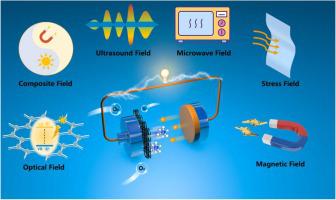当前位置:
X-MOL 学术
›
Nano Energy
›
论文详情
Our official English website, www.x-mol.net, welcomes your feedback! (Note: you will need to create a separate account there.)
Field-assisted metal-air batteries: Recent progress, mechanisms, and challenges
Nano Energy ( IF 17.6 ) Pub Date : 2024-03-28 , DOI: 10.1016/j.nanoen.2024.109550 Wenliang Wang , Tao Yu , Ying Cheng , Xuefei Lei , Biao Wang , Rui Guo , Xuanwen Liu , Junhua You , Xiaoxue Wang , Hangzhou Zhang
Nano Energy ( IF 17.6 ) Pub Date : 2024-03-28 , DOI: 10.1016/j.nanoen.2024.109550 Wenliang Wang , Tao Yu , Ying Cheng , Xuefei Lei , Biao Wang , Rui Guo , Xuanwen Liu , Junhua You , Xiaoxue Wang , Hangzhou Zhang

|
Metal-air batteries are recognized as a next-generation solution for energy storage with high energy density and environmental protection. However, the development of air batteries has been severely limited due to slow cathodic kinetics, which result in large overpotentials and low round-trip efficiency. In recent years, the research on field assisted metal-air batteries has garnered increasing attention. This review systematically discusses the impact of optical fields, magnetic fields, ultrasonic fields, internal stress fields, microwave fields, and composite fields on the charging and discharging processes of air batteries. Optical fields possess the ability to excite electrons within electrode materials, alternatively transforming light energy into heat, which consequently facilitates electrochemical reactions. Magnetic fields have the potential to change the orientation of the magnetic moment in electrode materials, affecting reaction rates and mass transfer processes. By introducing ultrasonic fields and internal stress fields, the kinetic processes of electrocatalytic reactions can be optimized. Microwave fields can improve the synthesis strategies of electrode materials. These external fields improve the performance and efficiency of metal-air batteries by effectively regulating the physical state, reaction rates, and mass transfer processes of electrode materials. Finally, the main challenges and possible future research directions for external field regulation strategies are summarized.
中文翻译:

场辅助金属空气电池:最新进展、机制和挑战
金属空气电池因其高能量密度和环保性而被公认为下一代储能解决方案。然而,由于阴极动力学缓慢,导致过电势大、往返效率低,空气电池的发展受到严重限制。近年来,场辅助金属空气电池的研究日益受到关注。本文系统地讨论了光场、磁场、超声场、内应力场、微波场和复合场对空气电池充放电过程的影响。光场具有激发电极材料内电子的能力,或者将光能转化为热能,从而促进电化学反应。磁场有可能改变电极材料中磁矩的方向,从而影响反应速率和传质过程。通过引入超声波场和内应力场,可以优化电催化反应的动力学过程。微波场可以改善电极材料的合成策略。这些外部场通过有效调节电极材料的物理状态、反应速率和传质过程来提高金属-空气电池的性能和效率。最后,总结了外场调控策略面临的主要挑战和未来可能的研究方向。
更新日期:2024-03-28
中文翻译:

场辅助金属空气电池:最新进展、机制和挑战
金属空气电池因其高能量密度和环保性而被公认为下一代储能解决方案。然而,由于阴极动力学缓慢,导致过电势大、往返效率低,空气电池的发展受到严重限制。近年来,场辅助金属空气电池的研究日益受到关注。本文系统地讨论了光场、磁场、超声场、内应力场、微波场和复合场对空气电池充放电过程的影响。光场具有激发电极材料内电子的能力,或者将光能转化为热能,从而促进电化学反应。磁场有可能改变电极材料中磁矩的方向,从而影响反应速率和传质过程。通过引入超声波场和内应力场,可以优化电催化反应的动力学过程。微波场可以改善电极材料的合成策略。这些外部场通过有效调节电极材料的物理状态、反应速率和传质过程来提高金属-空气电池的性能和效率。最后,总结了外场调控策略面临的主要挑战和未来可能的研究方向。



























 京公网安备 11010802027423号
京公网安备 11010802027423号